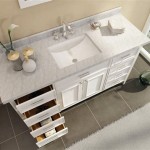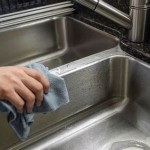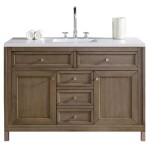Removing Rust From Sink Drains
Rust in sink drains is a common problem, particularly in homes with older plumbing systems or hard water. It not only detracts from the appearance of the sink but can also impede water flow and, if left untreated, potentially lead to more serious plumbing issues. Removing rust from a sink drain requires a systematic approach, combining appropriate cleaning materials, tools, and preventative measures. This article details several effective methods for tackling rust in sink drains, outlining the necessary steps for each approach and emphasizing safety precautions.
The formation of rust in sink drains is primarily attributed to the oxidation of iron. Iron pipes, frequently found in older homes, are susceptible to rust. Hard water, rich in minerals like calcium and magnesium, accelerates the corrosion process. When water containing dissolved iron comes into contact with oxygen, a chemical reaction occurs, resulting in the formation of iron oxide, commonly known as rust. Over time, this rust accumulates, causing discoloration and potentially restricting the drain's capacity. Ignoring rust can lead to the deterioration of the drainpipe itself, requiring costly repairs or replacements.
Identifying the Severity and Location of Rust
Before attempting any rust removal techniques, it is crucial to accurately assess the extent of the rust and its location within the drain system. Minor surface rust may be easily addressed with basic cleaning methods. However, extensive rust, particularly deep within the drainpipe, may require more aggressive treatments or even professional intervention. Begin by visually inspecting the visible portions of the drain, including the drain stopper, the area around the drain opening, and any exposed pipes beneath the sink. Use a flashlight to illuminate the interior of the drain as much as possible. Look for discoloration, flaking, or any noticeable build-up of reddish-brown material. If possible, carefully remove the drain stopper to examine its underside for rust. If the visible rust appears minimal, proceed with simpler cleaning methods. If the rust is extensive or located deep within the drain, consider more advanced techniques or consulting a plumber.
Furthermore, it is important to consider the material of the drainpipe itself. While iron pipes are the most prone to rust, other materials like copper or PVC can also be affected by rust originating from other sources, such as tools or fixtures that have rusted and transferred particles into the drain. Understanding the pipe material will help determine the most appropriate and safe cleaning methods to use.
Utilizing Natural Cleaning Solutions
For light to moderate rust accumulation, natural cleaning solutions often prove effective and are generally safer for both the plumbing and the environment. Several readily available household items can be used to create rust-removing solutions. These options are typically less harsh than chemical alternatives and are less likely to damage the drainpipe. Furthermore, they typically do not produce hazardous fumes. However, it is important to test any cleaning solution in an inconspicuous area first to ensure it does not discolor or damage the surrounding surfaces.
One popular method involves using a combination of baking soda and vinegar. Baking soda is a mild abrasive that can help to physically remove rust particles, while vinegar is a mild acid that helps to dissolve rust. To use this method, start by pouring approximately half a cup of baking soda down the drain, followed by one cup of white vinegar. The mixture will likely fizz and foam, which is a normal reaction indicating that the cleaning process is underway. Allow the mixture to sit in the drain for at least 30 minutes, or preferably overnight, to allow the vinegar to fully penetrate and dissolve the rust. After the soaking period, flush the drain with hot water for several minutes to rinse away the loosened rust and cleaning solution. This process can be repeated as necessary until the rust is visibly reduced or eliminated.
Another effective natural solution is lemon juice and salt. The acidity of lemon juice works similarly to vinegar in dissolving rust, while the salt acts as a mild abrasive. Sprinkle a generous amount of salt around the drain opening and then pour lemon juice over the salt. Allow the mixture to sit for several hours, or overnight, and then scrub the area with a non-abrasive brush or sponge. Rinse thoroughly with hot water. This method is particularly useful for removing rust stains around the drain opening and on the drain stopper.
For more stubborn rust, a paste made from baking soda and water can be applied directly to the affected areas. Mix baking soda with just enough water to create a thick paste. Apply the paste to the rust and let it sit for several hours before scrubbing with a non-abrasive brush. Rinse thoroughly with water. This method provides a more concentrated cleaning action for localized rust deposits.
Employing Chemical Rust Removers
When natural cleaning solutions prove insufficient, chemical rust removers offer a more potent alternative. However, it is crucial to exercise caution when using these products, as they often contain harsh chemicals that can be harmful to both the plumbing and the user. Always wear appropriate safety gear, including gloves and eye protection, and ensure adequate ventilation when working with chemical rust removers. Carefully read and follow the manufacturer's instructions for proper usage and disposal. Never mix different chemical cleaning products, as this can create dangerous fumes. Several commercially available rust removers are specifically formulated for use in drains and plumbing systems. These products typically contain acids or other chemicals that dissolve rust effectively.
One common type of chemical rust remover contains hydrochloric acid. These products are highly effective at dissolving rust but must be used with extreme caution. Hydrochloric acid can corrode certain types of pipes, particularly older metal pipes, and can cause severe burns if it comes into contact with skin or eyes. When using hydrochloric acid-based rust removers, always dilute the product according to the manufacturer's instructions and avoid prolonged exposure to the drainpipe. After applying the rust remover, thoroughly flush the drain with cold water for an extended period to neutralize any remaining acid. Proper disposal of the used product is also essential, following all local regulations.
Another type of chemical rust remover uses phosphoric acid as the active ingredient. Phosphoric acid is generally considered less corrosive than hydrochloric acid but is still effective at removing rust. It works by converting the iron oxide into a more easily removable compound. Phosphoric acid-based rust removers are often available in gel or liquid form and can be applied directly to the affected areas. Follow the manufacturer's instructions for application and rinsing, and always wear appropriate safety gear.
It is important to note that some chemical drain cleaners, designed primarily for unclogging drains, may also contain rust-removing properties. However, these products are often formulated for general drain cleaning and may not be as effective at removing rust specifically. If using a drain cleaner with rust-removing properties, carefully review the product label to ensure it is safe for use on the specific type of drainpipe in question.
Mechanical Removal Techniques
In some cases, mechanical removal techniques may be necessary to dislodge stubborn rust deposits from sink drains. These methods involve physically scrubbing or scraping away the rust using various tools. Mechanical removal is particularly useful for addressing surface rust or rust accumulation around the drain opening and drain stopper. However, it is important to use caution to avoid damaging the drainpipe or surrounding surfaces.
A simple and effective mechanical removal tool is a wire brush. Choose a brush with bristles that are stiff enough to remove rust but not so abrasive that they will scratch or damage the drainpipe material. Gently scrub the affected areas with the wire brush, applying moderate pressure to dislodge rust particles. Be careful not to apply excessive force, which could damage the drainpipe. After scrubbing, thoroughly rinse the drain with water to remove any loose rust particles.
For rust inside the drainpipe, a drain snake with a brush attachment can be used. A drain snake is a flexible tool that can be inserted into the drain to break up clogs and remove debris. A brush attachment can be added to the end of the drain snake to help scrub away rust from the interior walls of the pipe. Insert the drain snake into the drain and carefully maneuver it through the pipe, rotating the brush attachment to dislodge rust. Periodically remove the drain snake to clean off any accumulated rust and debris. Continue this process until the rust is visibly reduced or eliminated. Flush the drain thoroughly with water after using the drain snake.
Another mechanical removal technique involves using a scraper or putty knife to carefully scrape away rust from the drain opening and drain stopper. Use a plastic or rubber scraper to avoid scratching the surface of the drain. Gently scrape away the rust, applying moderate pressure. Rinse the area frequently with water to remove loose rust particles. This method is particularly useful for removing rust from intricate areas around the drain opening and on the drain stopper.
When using any mechanical removal technique, it is crucial to avoid using abrasive cleaners or scouring pads, as these can scratch or damage the drainpipe and surrounding surfaces. Opt for gentle scrubbing motions and non-abrasive tools to minimize the risk of damage.
Preventative Measures to Inhibit Rust Formation
Preventing rust formation in sink drains is often easier and more cost-effective than removing it. Several preventative measures can be implemented to minimize the risk of rust accumulation and extend the lifespan of plumbing systems. These measures focus on reducing the exposure of iron pipes to water and oxygen, mitigating the effects of hard water, and regularly maintaining the drain system.
One of the most effective preventative measures is to minimize the amount of water that sits in the drainpipe for extended periods. Avoid leaving standing water in the sink for prolonged periods, as this can increase the likelihood of rust formation. After using the sink, ensure that all water drains completely and that the drain stopper is properly sealed to prevent water from seeping into the drainpipe. This is particularly important in homes with iron pipes, as these pipes are more susceptible to rust when exposed to water.
Another important preventative measure is to address hard water issues. Hard water contains high levels of minerals, such as calcium and magnesium, which can accelerate the corrosion process. Installing a water softener can significantly reduce the mineral content of the water, thereby minimizing the risk of rust formation. Water softeners work by removing calcium and magnesium ions from the water, replacing them with sodium ions. This softened water is less likely to cause corrosion and rust formation in plumbing systems.
Regularly flushing the drain with hot water can also help to prevent rust accumulation. Hot water helps to dissolve and flush away any loose rust particles or mineral deposits that may be forming in the drainpipe. Run hot water down the drain for several minutes at least once a week to help keep the drain clean and prevent rust build-up. Additionally, periodically cleaning the drain with a mild solution of baking soda and vinegar can help to prevent the accumulation of rust and other debris.
Finally, consider replacing older iron pipes with newer, more corrosion-resistant materials, such as copper or PVC. While this may be a more costly undertaking, it can provide a long-term solution to the problem of rust in sink drains. Copper and PVC pipes are less susceptible to rust and corrosion, and they can significantly extend the lifespan of plumbing systems. If replacing iron pipes is not feasible, consider applying a rust-inhibiting coating to the exterior of the pipes to help protect them from corrosion.

Removing A Rust Stain From Sink Youtube

How To Remove Rust Stains From Sink Tub Mr Handyman

How To Replace A Rusty Sink Drain Howtolou Com

How To Remove Rust Stains From Toilets Tubs And Sinks

How Did I Get Rust Stains In My Sink Punctual Plumber Dallas

Rust In Your Stainless Steel Sink Duncan S Creative Kitchens

How To Fix A Rusted Sink Drain Hometalk

Rusting Bathroom Sink Hometalk

How To Fix The Enamel On A Bathtub Stop Rust Formation

Here S How To Remove Rust Stains From Your Bathroom







